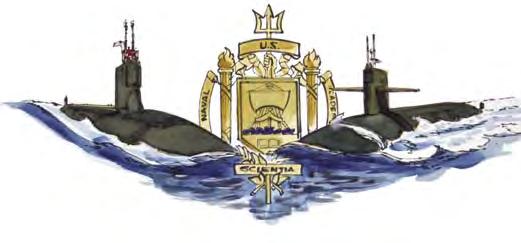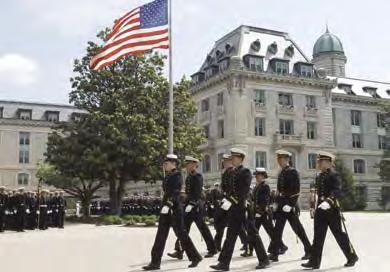
6 minute read
The Naval Academy’s Path to the Submarine Community
Art by Nate Ostrow
When midshipmen at the U.S. Naval Academy enter their preferences for service assignment, it commits them to a career path and a way of life for at least five years after graduation and commissioning. It’s crucial for these future officers to have the resources they need to make their decision. The Naval Academy ensures its midshipmen have a wide variety of experiences and exposure to the submarine community, allowing them to make informed and educated decisions.
Advertisement
Most midshipmen choose their service community in November of their senior year. Since 2003, however, the Admiral Frank L. Bowman Scholarship Program allows as many as 20 midshipmen secondclass to commit to the nuclear Navy in the spring of their junior year. These potential candidates are interviewed in late March and, if selected, receive their bonuses at that time. Bowman Scholars also participate in a summer internship during their first-class summer, an academic research project during their senior year, and have seats at the Naval Postgraduate School for immediate graduate education programs upon graduation from the Academy.
In 2006, qualified members in the top 500 of their junior class in order of merit were granted the opportunity to interview early, even if not in the Bowman Scholar program. Fifty-four midshipmen from the Class of 2007, including Bowman Scholars, selected submarines early. The remainder of the submariners from the class of 2007 will be selected in the fall.
Joining the submarine community must be a carefully weighed decision for any future naval officer. To help midshipman make the right choice, the Naval Academy offers a variety of programs, ranging from academic curriculum to social interaction to fleet-experienced mentors, all designed to expose midshipmen to challenges and opportunities available in the submarine career field.
Much of this exposure comes from the Professional Development Program at the U.S. Naval Academy, which provides midshipmen the perspective they need to make a confident decision through summer training, periodic events on the Yard, the Academy’s “Dolphin Club,” submarine officers in Bancroft Hall, and instructors in the academic departments. Midshipmen get exposure to the people, places and ships that make up the submarine community. This exposure provides them the familiarity they need to make their decision.
Summer programs open up the fleet to midshipmen and let them see the Submarine Force firsthand. Most midshipmen second-class – college juniors – participate in Professional Training for Midshipmen, or PROTRAMID, a monthlong look at various communities in the Navy.
A full week is devoted to submarines during which midshipmen go through simulators, tour facilities, and get underway overnight onboard a submarine. They have the chance to talk to officers and enlisted men about their experiences. PROTRAMID is considered a very valuable experience, and often contributes strongly to midshipmen’s decision to “go submarines.” Being in Kings Bay, Ga., and getting to see the community firsthand can provide great perspective on the most important personal decision the Navy’s future officers make at the Naval Academy.
The Naval Academy also offers its midshipmen two programs that are more submarine specific, SUBTRAMID (Submarine Training for midshipmen) and fleet submarine cruises. SUBTRAMID, a two week program, includes many of the same aspects as PROTRAMID, but for a longer period of time. The midshipmen
embark on deployed submarines for longer cruises and get to see and participate in operations around the world.
Midshipman 2/C Mike Eyler embarked aboard USS Helena (SSN-725) for two weeks for SUBTRAMID during the summer of 2005. “I liked the exercises we did. I thought it was neat that we could be so successful in these exercises,” Eyler said. “A lot of the time it seemed like we won ‘the game’. That was pretty sweet.”
During the academic year there are officers assigned and programs available on the Yard to enhance midshipmen’s knowledge about the Submarine Force. The “Dolphin Club,” for example, hosts events for midshipmen interested in the submarine community. Lt. Derek Dryden, one of the Brigade of Midshipmen’s company officers, is the officer representative for the “Dolphin Club.” Dryden and Midshipman 1/C Scott Becknell, “Dolphin Club” president, are in charge of putting on events that will introduce interested midshipmen to submarine officers in the area.
Among the biggest of these events is the annual Submarine Birthday Ball, attended by midshipmen, Academy officers, retired submariners, and their guests. The birthday ball is a rare opportunity for these prospective submariners to talk to men who served in the Submarine Force during World War II, the Korean War, and the Cold War. Guests don their dinner dress blues and enjoy a dinner in Smoke Hall. The “Dolphin Club” also hosts tailgaters at home football games and organizes picnics, usually hosted by one of the officers living on the Yard.
Midshipman 1/C Nick Marston cites the generosity of the officers on the Yard as a great characteristic of the “Dolphin Club.” He said their welcoming attitude encourages midshipmen to get involved and to learn about the community, and that they are open about their experiences in the submarine community, giving midshipmen a realistic look at what they can expect if they go sub.
The Academy also hosts periodic Career Information Program briefs for midshipmen, giving them information about current submarine operations and introducing them to submarine officers from submarine bases around the country. These briefs show midshipmen the Navy’s current Submarine Force, its leaders, and missions. These programs allow midshipmen to hear how the submarine community is contributing to the War on Terror directly from experienced warfighters. They get fleet perspective on the relevance of the Submarine Force, modern requirements of the U.S. Navy, and how active submarines have been fulfilling those requirements.
The Academy has a network of officers throughout the Yard to help answer questions and prepare midshipmen for interviews at Naval Reactors. Each company has a submarine representative available to help. In prepping a prospective submarine candidate, the officers will help midshipmen with interview questions and interview “dos and don’ts.” In addition to preparing midshipmen for interviews, some company officers will also accompany their midshipmen to the interview itself.
Every midshipman considering submarines has the chance to benefit from this kind of preparation. The officers who facilitate this process often provide insight from their own interview experience, and for some, insight they’ve gained from serving as interviewers as well.
There are also many submarine officers who serve as academic instructors on the Yard. They act as ambassadors for the submarine community every day in class, and make up a large part of midshipmen’s attitudes towards the community. These instructors give midshipmen a more personal look at the community and someone they can interact with on a daily basis to learn about submarines.
“The officer who impressed me the most was my Boats instructor,” said Eyler. “He
photo courtesy of USNA Photo Lab
was a great instructor who conveyed the importance of technical competence in the Submarine Force,” he said.
The Naval Academy offers a specific curriculum that has direct application to the nuclear Navy, and specifically, submarines. All midshipmen first-class – or seniors – selecting submarines take the Junior Officer practicum in the Spring. The midshipmen also have the option of taking an alternate Steam course, which includes a look at naval nuclear reactors. For a more in-depth study of nuclear power, the Mechanical Engineering department offers a Reactor Physics course, and the Physics department offers a course titled Underwater Acoustics and Sonar. The professional courses all midshipmen take include portions on the submarine community.
Whether it’s behind the desk, behind the lectern, or behind the periscope, the Naval Academy has a diverse and real-world program in place to introduce its future officers to the Navy’s submarine community. This program is designed to ensure that experienced fleet-warriors have a direct impact on the up-and-coming submariners that will lead the community forward to meet the challenges ahead.
Midn. 1st Class Alexander Ludington is a U.S. Naval Academy senior majoring in Physics. Upon graduation, Midn. Ludington will enter the submarine community. He conducted his PROTRAMID aboard USS Albany (SSN-753).










